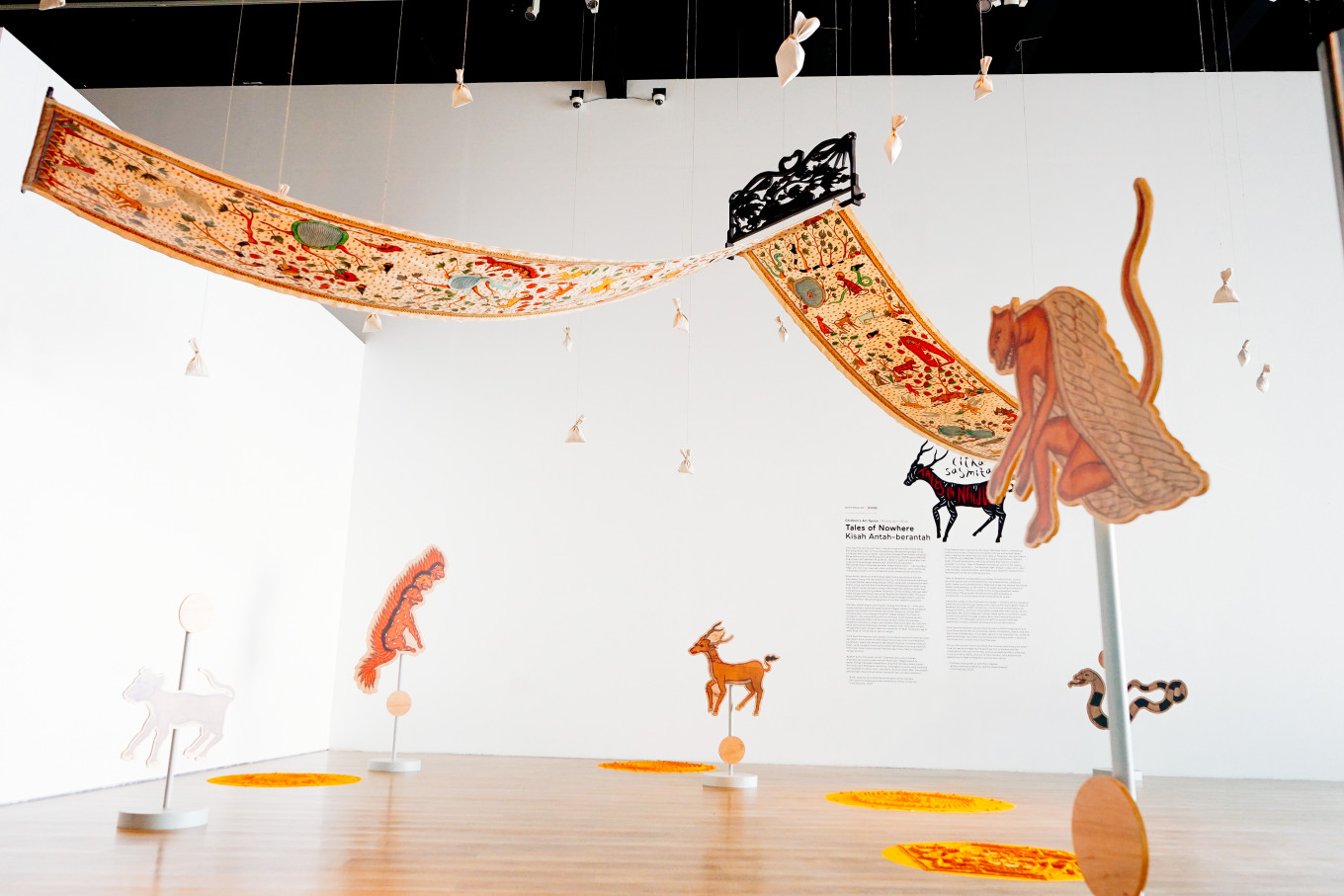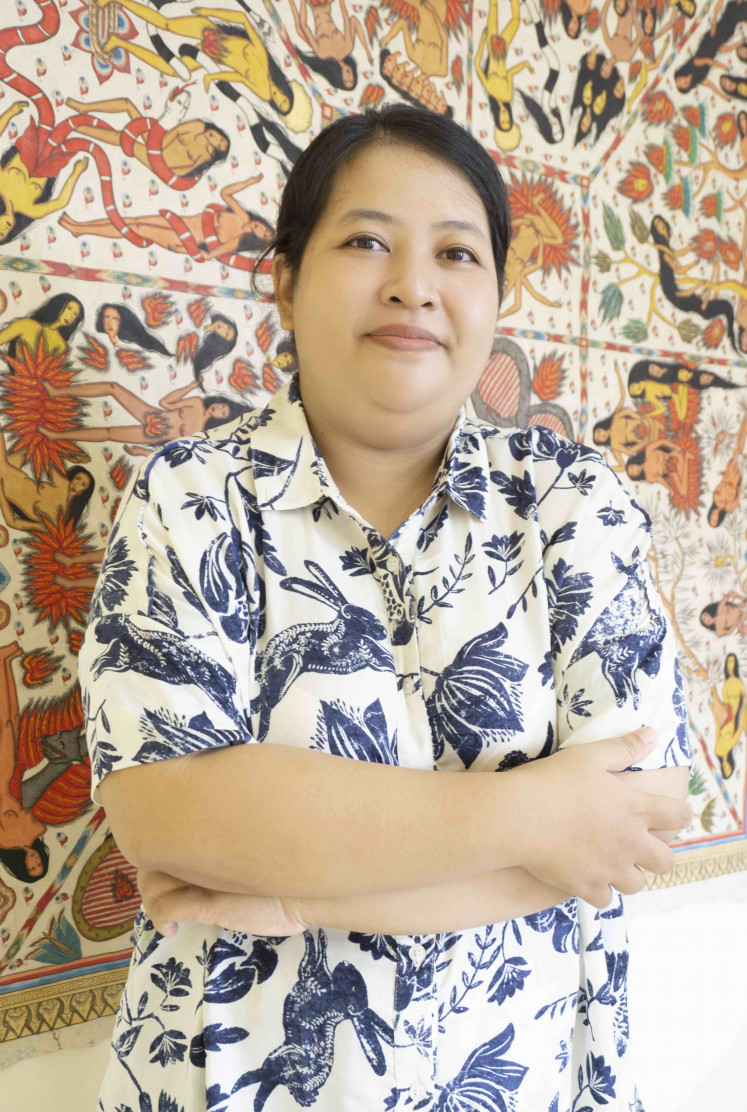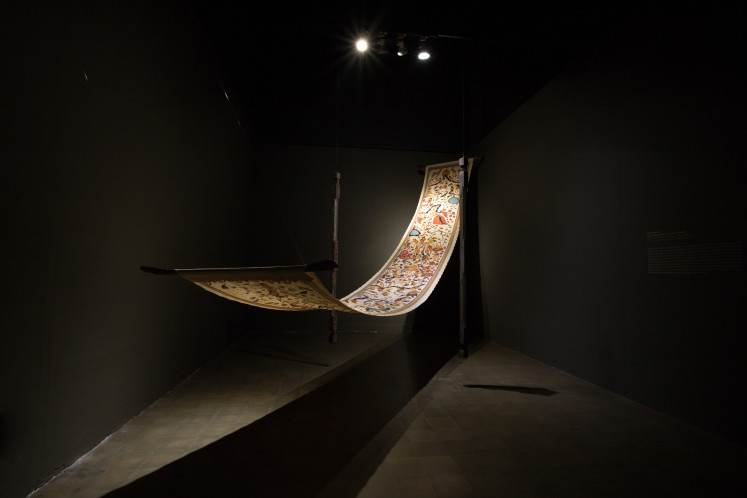Popular Reads
Top Results
Can't find what you're looking for?
View all search resultsPopular Reads
Top Results
Can't find what you're looking for?
View all search resultsArtist Citra Sasmita “hacks” patriarchal Balinese traditions
Change text size
Gift Premium Articles
to Anyone
G
rowing up in a less privileged family from a low caste in Bali and being discriminated against as a woman, Citra Sasmita brings forth equality issues in her artworks.
Inside one of the display rooms at Biennale Jogja 2019, five long canvases are hung beautifully. Each depicts dozens of naked female figures with long hair and playing with fire, water and plants. Beneath the paintings, the title of the artwork was written with turmeric powder on the floor — it reads Timur Merah Project: The Embrace of My Motherland. Beautiful yet striking, feminine yet strong, the artwork belonged to artist Citra Sasmita.
Born in Bali on March 30, 1990, Citra Sasmita is an artist who focuses on women's issues. Through her art, she challenges Bali’s patriarchal system that has existed for generations.
Since her first exhibition in 2015, Citra has utilized many legends, myths and narratives from ancient Balinese manuscripts, reconstructing them into a narrative that presents more equality between genders.
"We Balinese have inherited a patriarchal narrative and mindset, so it is natural that our daily practice is very discriminatory,” Citra detailed why she took this approach in art. “Kids like me grow up with lots of boundaries and control.”
Past and upcoming work
At Citra Sasmita's studio in Batubulan, Gianyar, Bali, rolls of traditional canvas are stacked in the corner of a room. A cup of coffee sits on her desk. It is her space to create art.
"Well, if my child has taken a bath and is asleep, I can only draw here," Citra said.
"In 2016, I conducted a social experiment at home,” she said. At that time, she was working on a project titled Mea Vulva Mea Maxima that would display 100 pieces of vaginal-shaped ceramics for an exhibition called Merayakan Murni (Celebrating Purity) which took place at Sudakara Artspace in Sanur, Bali, in 2016. To dry her ceramics, she hung them out in front of her house where many people passed by.
"It was interesting and strange to see that many people were disgusted by the shape of the vagina, while in Bali it is common for people to see penis-shaped souvenirs being sold everywhere," she frowned.
Citra found inspiration in the late I Gede Ayu Kadek Murniasih, a Balinese artist who gained popularity in the 1990s and talked a lot about feminism before she passed away in 2006. “Early in my career when I was still looking for a patron, I found Murni. But it was a shame we didn't get the chance to meet in person. As a female artist who was vocal in that generation, she must have been in a very difficult position. I also feel the pressure. Murni was able to create her own complex language symbols to read the patriarchal situation in Bali at that time. It gave me clues."
Citra then moved on to show her artwork for the Kathmandu Triennale 2077, an international exhibition for contemporary arts in Nepal, which will take place in March. “For this event, I’m going to highlight Balinese rituals on worshipping nature. Talking about human relations with nature is a real and raw occurrence I experience as a Balinese."
Citra shares her story, ideas and messages for fellow women.
Meet the artist: Being discriminated against as a woman, Citra Sasmita learned about feminism and finally found her artistic statement and methods. (Courtesy of Citra Sasmita) (Citra Sasmita/Courtesy of Citra Sasmita)What experiences made you aware of women’s issues and decide to voice it through your artwork?
It was a long journey. As a Balinese daughter, I have a Balinese name "Ni Putu", which means I don't come from a privileged family [or a high social caste], not like "Raden" or "Agung" [higher caste title]. The caste system is still very much in effect in Bali. So, kids like me live with lots of boundaries and controls. You can't talk freely or be critical – but, why is that? Why can’t we be critical? I found it difficult to get the answers to those questions.
Thankfully, I met Oka Rusmini and my theater friends at university where I learned to express and speak my opinion. I learned a lot, especially with Oka Rusmini who offered me a position as a short story illustrator at Bali Pos in 2012. Aside from reading a lot of short stories, I was also encouraged to learn about “eastern” feminist theory. Soon I realized, the issue that I thought was personal turned out to be a collective experience among Balinese women. Everyone experiences it, only they don't know how to express it and don't see other choices.
Apart from studying feminism, has your work as an illustrator influenced your current works?
Yes, of course. Perhaps an illustrator's work generally serves to describe, while mine is more to narrate. I learned to look for symbols from literary works which are usually poetic and symbolic.
At one point you said, "Women in my work are not just a theme, but a language." Can you tell us more?
Language is complex as it involves analyzing and telling a condition. Even if I pick up the text of an old manuscript and I contextualize it in my work, I think about how to make it relevant to what is happening today. For example, my work The Verge of Mortal Ground [Artjog 2020] was from Calon Arang, [a female character in Javanese and Balinese folklore]. Legend has it that one time there was an epidemic and people were not allowed to leave the house. But mystical narratives depict that the plague was caused by the evil witch Calon Arang. The situation is similar [to what we experience] now: isolation, lockdown, you name it.
Almost all of your recent works are titled the Timur Merah Project (Red East Project). Can you explain what that is?
It's my long-term research project that started in 2019. I research traditional Balinese art, especially Kamasan paintings, which was the first painting [style] that developed in Bali in the 15th century. I reread whether Bali is geopolitically important in the constellation of world history. [I question] what makes Bali valuable apart from tourism, souvenirs and exotic impressions.
So, I used traditional Kamasan canvases for this project. Then, because I couldn't read ancient Balinese scripts, I learned a lot about the narratives from Mangku Muryati, a female priest in Kamasan. When she was appointed a priest in 1996, it was quite controversial because there had never been a female priest.
Speaking of women, what do you think of the position of women in Bali today?
Today, it's much better because there seems to be resistance [toward the patriarchy]. In the past, women had no bargaining power at all, especially in the law on inheritance rights and victims of sexual violence, and it was written in customary law. For example, a rape victim must be married to the rapist so that the Desa Adat [customary village] is not “dirty”. We continue to fight that. Many non-profit organizations have started to provide legal awareness for women in Balinese villages. There have been changes.
Does that mean that in the past, Balinese women were not only discriminated against because of caste, but also due to their gender?
Yes, it's that bad. Especially in the area of art and intellectualism, it was very difficult for women to receive proper appreciation. Now it's better. We created the Futu Wonder collective to break that stigma. For example, we organized Wikipedia training, wrote the history of Balinese female artists that had never been recorded and held exhibitions as well.
But aren't there many Hindu philosophies adopted by Balinese people that are pro-gender equality?
This is what the Pedanda [Balinese priests have always claimed to deny the existence of patriarchal problems. Indeed, we inherit, for example, the Lingga-Yoni artifact at Besakih Temple in Bali, which is a symbol of equality. Without Lingga and Yoni [symbols of fertility and virility], there would be no life, and the figure of God is described as genderless as well. But in reality, there is a gap. And I think that's what we should "hack".
On display: A look of the installation by Citra Sasmita at the ARTJOG MMXXI exhibition in Yogyakarta in 2021. (Courtesy of Citra Sasmita) (Citra Sasmita/Courtesy of Citra Sasmita)Why do you think it's important to hack legends and myths instead of, for example, customary rules?
We live in that culture. Those legends and myths have become a part of our lives. So, I believe artworks based on those narratives are easy to understand. I don’t need to explain my work to the public. In addition, my work can be a bridge to the wider culture of Southeast Asia, because it turns out that the story I shared is also experienced by women in another part of the world. We're all connected.
Of the many legends and myths of Hinduism in Bali, which one annoys you the most? Is it Calon Arang?
Yes, apart from being reproduced in many mediums, Calon Arang is familiar to me. Here, Calon Arang is usually performed at traditional events. There is one scene depicting Calon Arang being possessed by a spirit that can do black magic. In Bali, there is a stigma that women who live long past 90 or 100 years are considered to have black magic. My great-grandma was 106 years old when she passed away last year. She was stigmatized as having black magic and the news spread to the surrounding villages. All because of the story of Calon Arang.
As a female artist who talks about women's issues, what is the most unpleasant response you have ever received?
Receiving critiques from men about feminism delights me. What annoys me is receiving responses from fellow women who don't support other women.
What do you think your old age will be like?
Maybe when I have cataracts, I'll take care of plants; I love cacti and philodragons [laughs].
Do you have any messages for young women?
Our voice is important. So, as long as we can express, struggle and find power, we must express anything that we keep pent-up in our minds.














